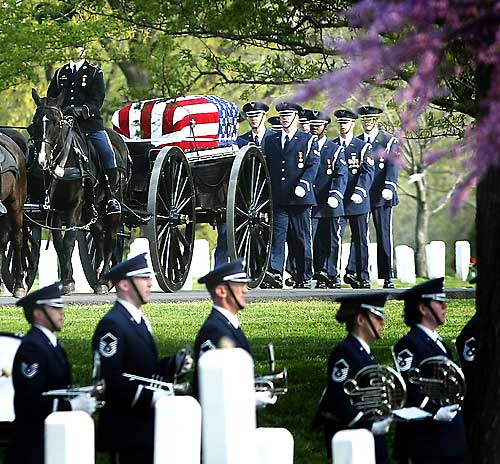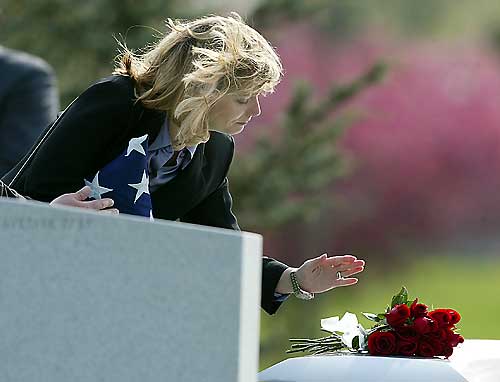
WASHINGTON — The daily movement of backhoes is beginning to wear brown ruts in the expanse of grass known as Section 60.
This is the corner of Arlington National Cemetery where the remains of 16 soldiers and airmen killed during Operation Iraqi Freedom have been laid to rest since April 10. The Pentagon says 131 of about 230,000 U.S. troops deployed have been killed in the war thus far.
Sometimes twice a day, uniformed pallbearers hoist flag-covered coffins and walk in lock step over these grounds. Mats were laid down after mourners treaded the turf into bare earth.
Groundskeepers are thankful many of the burials have taken place during daylight-saving time, giving them an extra hour to dig and prepare the graves for the next morning's services.
Section 60 is about 2,500 feet from the Visitor's Center and a brisk walk from the cemetery's main attraction, the John F. Kennedy memorial. It's part of the 624-acre site visitors rarely see, chosen for its healthy grass and because “we had plenty of room,” said John Metzler, Superintendent of Arlington National Cemetery.
“We didn't know what the bottom number (of war deaths) was going to be when we started.”
The nation says its final goodbyes to many of its servicemen, astronauts and military heroes at Arlington National Cemetery, just across the Potomac River from Washington, D.C. Families of those killed in combat choose whether to bury them here or closer to home.
Behind the carefully scripted military funerals are dozens of tiny considerations, from scheduling honor guards to ordering headstones.
Trying to predict how many causalities might be brought home from Iraq was among the first concerns for Metzler and his staff.
Before Operation Desert Storm in 1991, lawmakers asked Metzler if Arlington could handle 10,000 dead. “I thought about this again when this second war broke out,” he said. “And, gosh, we weren't talking so much about numbers but about weapons of mass destruction.”
On average, there are 25 burials a day at Arlington National Cemetery, mostly of retired veterans and their spouses. Metzler wondered how he could keep that schedule with a sudden influx of active-duty deaths.
The cemetery has been able to bury the dead from Iraqi Freedom and maintain its previous commitments, though groundskeepers sometimes skip lunch and work longer days.
The biggest stress comes from making sure the military processionals have enough time to move between services, Metzler said.
“They need enough time to finish a service, straighten themselves up, reload their weapons, and march to a designated spot and not literally run from one grave to the next,” he said.
Schedulers also take into account the added time many families spend at the graves of those killed in combat.
And the Iraqi Freedom ceremonies of the last two weeks have attracted bigger crowds than most burials, as comrades of the deceased show their respects. The Pentagon is close by, and officers from the various branches of the armed services come by to acknowledge their own.
Chaplain Captain Mark Thomas said he observed a sea of blue Air Force uniforms at the funeral of Major Gregory Stone on April 17.
Stone, 40, who grew up in Portland, was killed March 25 in Kuwait by a hand grenade allegedly thrown by a U.S. serviceman.

During his eulogy, Thomas remarked: “This final resting place, looking down upon this, our nation's Capitol, is fitting for Major Stone. He will rest here with those of like mind and determination.”
After Stone's fiancée kissed her hand and pressed it to the coffin, the family and assembled generals turned and walked slowly from the gravesite.
Groundskeepers arrived, one wearing a baseball cap turned backward, and slipped the coffin into the ground.
The family is not present at this moment, said Metzler, because “you just don't know what's going to happen.”
“Instead of running the risk that someone in the middle of closing the grave decides that they have to have another two minutes with their loved one, we ask everyone to leave so our workmen can do their jobs quickly and move on to the next service.”
Supervising all these tasks is methodical work, but Metzler, 55, grew up at Arlington National Cemetery. His father was superintendent for 21 years, and Metzler lives in his old house on the grounds.
He remembers when Section 60 was temporary military housing, a place where he and his brothers once played, before he went to fight in Vietnam. It was bulldozed to expand the cemetery in the late 1960s.
Metzler still likes to stroll the grounds, picking stray dandelions and getting lost in the rows of white markers.
Reading the headstones is like a course in American history.
Unlike the fallen from the first Gulf War, most of the dead from Iraqi Freedom were killed in a two-week period and thus will be buried in the same area.
Sometime in the future, family members, tourists and historians will walk through Section 60 and see the names of countries such as Iraq, Kuwait and Afghanistan etched into the marble.
But the headstones haven't arrived yet, so the graves are now marked by small plastic name cards. And mounds of fresh flowers.
Arlington National Cemetery
• The grounds of Arlington National Cemetery are the former estate of Robert E. Lee, seized by Union troops at the start of the Civil War. The grounds were appropriated as a military cemetery in 1864.
• More than 260,000 men and women are buried there.
• Veterans of every U.S. war are buried in Arlington. Ten veterans of the Revolutionary War have been reinterred at the cemetery.
• Those eligible to be buried at Arlington include active-duty personnel, military retirees, retired reservists aged 60 and over, recipients of the military's highest decorations, and former prisoners of war. Eligibility also is extended to spouses.
• U.S. presidents William Howard Taft and John F. Kennedy are buried there.
• Other notables buried there include boxer Joe Louis, bandleader Glenn Miller, actor Lee Marvin, writer Dashiell Hammett and baseball founder Abner Doubleday.
• 4 million people visit the cemetery each year.
• Tahoma National Cemetery in Maple Valley is a National Cemetery in Washington state, which also has several smaller veterans cemeteries.
Michael Robert Patterson was born in Arlington and is the son of a former officer of the US Army. So it was no wonder that sooner or later his interests drew him to American history and especially to American military history. Many of his articles can be found on renowned portals like the New York Times, Washingtonpost or Wikipedia.
Reviewed by: Michael Howard
